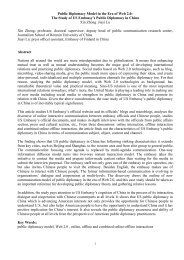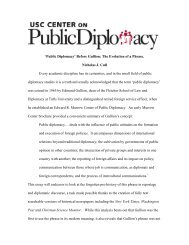Buddhist Diplomacy: History And Status Quo. - USC Center on ...
Buddhist Diplomacy: History And Status Quo. - USC Center on ...
Buddhist Diplomacy: History And Status Quo. - USC Center on ...
- No tags were found...
You also want an ePaper? Increase the reach of your titles
YUMPU automatically turns print PDFs into web optimized ePapers that Google loves.
BUDDHIST DIPLOMACY: HISTORY AND STATUS QUO 9missi<strong>on</strong>aries to the world bey<strong>on</strong>d the Indian subc<strong>on</strong>tinent to spreadthe Dharma. 191. Emperor Asoka’s “C<strong>on</strong>quest by Dhamma”In his campaign to unite the India subc<strong>on</strong>tinent, Emperor Asokaengaged in battles against Kalinga in the year around 261 BCE. Inthe war, more than 100,000 people were killed. 20 The bloody battleprompted him to devote his life to n<strong>on</strong>-violence and to “feel a str<strong>on</strong>ginclinati<strong>on</strong> towards the Dhamma, a love for the Dhamma and forinstructi<strong>on</strong> in Dhamma”, as is recorded in the Edicts of King Asoka. 21Under the patr<strong>on</strong>age of the emperor, the Third <str<strong>on</strong>g>Buddhist</str<strong>on</strong>g> Council wasc<strong>on</strong>vened in about the year of 250 BCE. The Council deputed ninemissi<strong>on</strong>aries to today’s Egypt, Syria, Maced<strong>on</strong>ia, Greece, Cyprus,Afghanistan, Kashmir, the Himalayas, and Sri Lanka to spread theBuddha’s teachings. 22 For the first time in human history, a largescalefaith diplomacy campaign communicated <str<strong>on</strong>g>Buddhist</str<strong>on</strong>g> messagesto three c<strong>on</strong>tinents, namely Asia, Africa and Europe.What motivated Emperor Asoka to promote Buddhismdomestically and internati<strong>on</strong>ally can be found in his edicts inscribed<strong>on</strong> the pillars, boulders and cave walls that were excavated in today’sIndia, Nepal, Pakistan, and Afghanistan. In these edicts, EmperorAsoka said he is “zealous toward Dhamma”, 23 and that he wishedthat: “[W]hen people hear these [Dhamma], they will follow them,elevate themselves and grow c<strong>on</strong>siderably through the promoti<strong>on</strong> ofthe Dhamma.” 24Emperor Asoka himself was initiated to become a m<strong>on</strong>k inthe Sangha. He believed that “progress am<strong>on</strong>g the people throughDhamma has been d<strong>on</strong>e by two means, by Dhamma regulati<strong>on</strong>s andby persuasi<strong>on</strong>….[w]hile persuasi<strong>on</strong> has much more effect.” For thispurpose, the Emperor ordered to set up Dharma pillars and appointedDharma Mahamatras, or officers in charge of Dharma. The duty ofthe Dharma Mahamatras was to “work am<strong>on</strong>g all religi<strong>on</strong>s for theestablishment of Dhamma, for the promoti<strong>on</strong> of Dhamma, and forthe welfare and happiness of all who are devoted to Dhamma.” 25Emperor Asoka’s policy is termed Dhammavijaya, or “c<strong>on</strong>quest by











